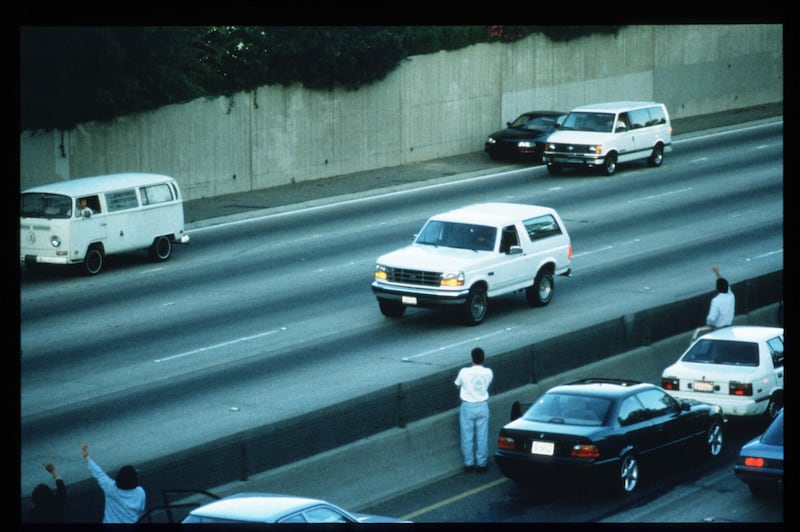News of the death of OJ Simpson flashed around Manhattan on Thursday lunchtime at lightning speed, but the reaction was muted. There were no conversations to be overhead on the street. The crowd milling through Penn Station took shelter from the sporadic bursts of rain; a classical trio played in Moynihan Hall and, although the news screens in the myriad eateries returned to Simpson’s death on their rolling updates, the audio was switched off.
Anyone who was interested could locate the news on their own newsfeed, on their own device. In a city perpetually pressing forward, nobody under 35 would have cared much about the demise of a figure whom, if they knew at all, they knew as a macabre grotesque of the 1990s.
Almost three decades have passed since the afternoon of June 17th, 1994, when the New York Knicks were trying to win the city a first championship since 1973 (a feat that still eludes them) on the shiny basketball floor in Madison Square Garden, which was built over the warren of corridors and train tracks of Penn Station. American sport was that summer still in mourning after the retirement of Michael Jordan the previous summer. The NBA finals, between the Knicks and Rockets, were lacklustre. A helicopter news camera began to send a feed from California of a cavalcade of police cars following a White Ford truck, a Bronco, in a bizarre, mesmerising slow chase. In the truck was OJ Simpson, threatening to shoot himself.
[ OJ Simpson, former sports star acquitted of murder, dies aged 76Opens in new window ]
By then, the football star turned actor-personality had moved from grieving husband to chief suspect in the gruesomely violent murder, five days earlier, of Nicole Brown, who was all but decapitated in a frenzied attack. Ron Goldman, a young man making his way in LA working as a waiter, and a visitor to Brown’s home, was also brutally savaged. NBC made the decision to cut from the finals and so the strange procession along the freeways of Los Angeles was played out in front of a national and global audience: 96 million people watched that car drive.

And 30 years on, it is difficult to think of another event where so many themes and tensions of American life of the mid-1990s intersected – or, rather, collided. Simpson’s trial for the murders illuminated the clear racial divisions between the black Los Angeleno community, who believed the LAPD to be inherently corrupt and biased, and the white community.
The televised trial; the spectacular missteps on the part of the prosecuting team; the composition of a jury deeply suspicious of the police authorities and the pure hysteria of the moment weren’t fully parsed for 23 years, until Ezra Edelman’s Made in America, a breathtaking documentary that laid out the life of The Juice, from the glorious athletic career to the moment when he was eventually imprisoned for his part in a farcical robbery attempt in 2009.
Edelman was never interested in swaying viewers one way or the other in their view of Simpson’s innocence or guilt. The sweep of the story conveys, as Edelman said in an interview, the dazzling nature of Simpson’s emergence as the first black athlete to be fully embraced into white corporate society, and it was important to dwell on “how beautiful a guy he was on the field and just to look at, and there is something about engaging with him in that way that makes his story that more tragic”.
The film doesn’t flinch from the shocking litany of domestic violent assaults inflicted by Simpson on Nicole Brown in the years and months before her death. It presents with utter detachment the views of the chief players in “The Trial of the Century”, a legal proceeding that looks surreal and amateurish in retrospect and presaged an era when real life and the televised life have blurred.
Nicole Brown was just 35 when she was murdered. Ron Goldman was 27. Both endured horrific injuries.
On Thursday night, among the jurors and allies plucked from a different time by the news networks, was Kato Kaelin, then a would-be actor who was thrust into the drama because he happened to be renting a studio from Simpson. Kaelin, now in deep middle age, explained how that summer shaped his life and recalled his last encounter with Simpson: minutes after he spoke against his former landlord in a deposition, he found himself alone with Simpson in the bathroom during a break. “And I was scared out of my mind, so I walked out. And he just said, ‘Hey, what’s up?’”
That was OJ Simpson as the coin flipped towards the dark: a once revered figure who now invoked fear, who would become a pariah and who must have understood that the very thing he craved most - the adoration of the people – was irrevocably out of his grasp.
OJ Simpson might have got away with murder, but The Juice could not.















